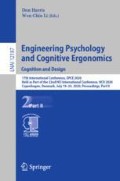Abstract
Real-time strategy games often times mimic the appearance and feel of military-like command and control systems. Artificial intelligence and machine learning research enjoys utilizing the environments produced by these games and are often focused on creating intelligent agents to beat them or accomplish high scores. Instead of creating these agents, or bots, to beat real-time strategy games, this work instead focuses on creating machine learning-driven agents to work with human players. However, due to the advancements in the deep learning field, machine learning models have become harder to understand, and are called ‘black-box models’ due to the inability to see the inner workings of such algorithms. To remedy this, we describe how we take human-autonomy teaming and explainable artificial intelligence techniques to shed light and provide inside for players to understand recommendations by the system.
Access this chapter
Tax calculation will be finalised at checkout
Purchases are for personal use only
Notes
- 1.
- 2.
- 3.
- 4.
Regulation (EU) 2016/679.
- 5.
- 6.
- 7.
References
Shively, R.J., Lachter, J., Brandt, S.L., Matessa, M., Battiste, V., Johnson, W.W.: Why human-autonomy teaming? In: Baldwin, C. (ed.) AHFE 2017. AISC, vol. 586, pp. 3–11. Springer, Cham (2018). https://doi.org/10.1007/978-3-319-60642-2_1
Ezer, N., Bruni, S., Cai, Y., Hepenstal, S.J., Miller, C.A., Schmorrow, D.D.: Trust engineering for Human-AI teams. In: Proceedings of the Human Factors and Ergonomics Society Annual Meeting, vol. 63, no. 1, pp. 322–362 (2019)
Reddy, S., Dragan, A.D., Levine, S.: Shared autonomy via deep reinforcement learning. arXiv prepreint arXiv:1802.01744 (2018)
Explainable Artificial Intelligence (XAI): DARPA Broad Agency Announcement, DARPA-BAA-16-53 (2016)
Rudin, C.: Stop explaining black box machine learning models for high stakes decisions and use interpretable models instead. Nature Mach. Intell. 1, 206–215 (2019)
Goodman, B., Flaxman, S.: European union regulations on algorithmic decision-making and a ‘Right to Explain’. AI Magazine 38(3), 50–57 (2017)
Ribeiro, M.T., Singh, S., Guestrin, C.: Why should i trust you?: explaining the predictions of any classifier. CoRR, abs/1602.04938 (2016)
Shrikumar, A., Greenside, P., Kundaje, A.: Learning important features through propagating activation differences. CoRR, abs/1704.02685 (2017)
Zeiler, M.D., Fergus, R.: Visualizing and understanding convolutional networks. CoRR, abs/1311.2901 (2013)
Selvaraju, R.R., Das, A., Vedantam, R., Cogswell, M., Parikh, D., Batra, D.: Grad-CAM: why did you say that? visual explanations from deep networks via gradiant-based localization. CoRR, abs/1610.02391 (2016)
Vinyals, O., et al.: StarCraft II: a new challenge for reinforcement learning. arXiv preprint:1708.04782
Lee, D., Tang, H., Zhang, J.O., Xu, H., Darrell, T., Abbeel, P.: Modular architecture for StarCraft II with deep reinforcement learning. In: AAAI Fourteenth Artificial Intelligence and Interactive Digital Entertainment Conference (2018)
Justesen, N., Risi, S.: Learning macromanagement in StarCraft from replays using deep learning. In: IEEE Conference on Computational Intelligence in Games, pp. 162–169 (2017)
Reed, A.E., Mikels, J.A., Lockenhoff, C.E.: Choosing with confidence: self-efficacy and preferences for choice. Judgm. Decis. Mak. 7(2), 173–180 (2012)
Synnaeve, G. et al.: Forward modeling for partial observation strategy games - a StarCraft defogger. In: Proceedings of the 32nd International Conference on Neural Information Processing Systems, pp. 10761–10771 (2018)
Sun, Y., Vu, K.-P.L.: Population stereotypes for color associations. In: Harris, D. (ed.) EPCE 2018. LNCS (LNAI), vol. 10906, pp. 480–489. Springer, Cham (2018). https://doi.org/10.1007/978-3-319-91122-9_39
Endsley, M.R.: Situation awareness global assessment technique (SAGAT). In: Proceedings of the IEEE 1988 National Aerospace and Electronics Conference (1988)
Kulesza, T., Burnett, M., Wong, W.-K., Stumph, S.: Principles of explanatory debugging to personalize interactive machine learning. In: Proceedings of the 20th International Conference on Intelligent User Interfaces, pp. 126–137 (2015)
Anderson, A., et al: Explaining reinforcement learning to mere mortals: an empirical study. CoRR, abs/1903.09708 (2019)
Author information
Authors and Affiliations
Corresponding author
Editor information
Editors and Affiliations
Rights and permissions
Copyright information
© 2020 This is a U.S. government work and not under copyright protection in the U.S.; foreign copyright protection may apply
About this paper
Cite this paper
Lucero, C., Izumigawa, C., Frederiksen, K., Nans, L., Iden, R., Lange, D.S. (2020). Human-Autonomy Teaming and Explainable AI Capabilities in RTS Games. In: Harris, D., Li, WC. (eds) Engineering Psychology and Cognitive Ergonomics. Cognition and Design. HCII 2020. Lecture Notes in Computer Science(), vol 12187. Springer, Cham. https://doi.org/10.1007/978-3-030-49183-3_13
Download citation
DOI: https://doi.org/10.1007/978-3-030-49183-3_13
Published:
Publisher Name: Springer, Cham
Print ISBN: 978-3-030-49182-6
Online ISBN: 978-3-030-49183-3
eBook Packages: Computer ScienceComputer Science (R0)

